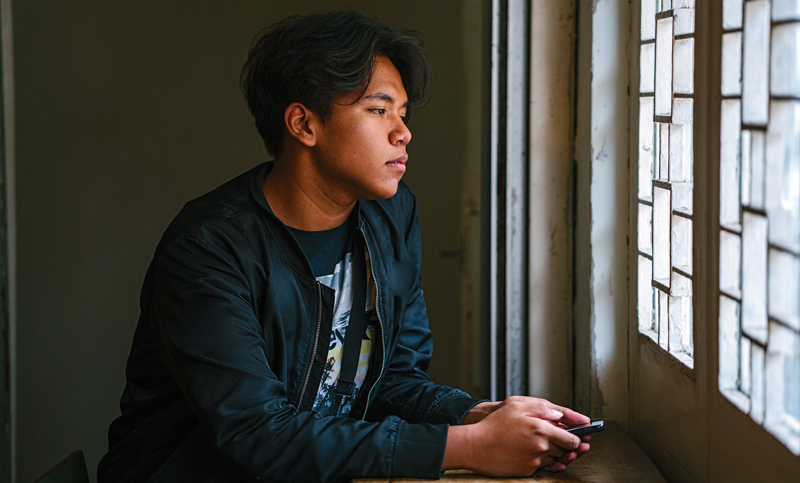After hearing the range of discussion sparked by Anti-Bullying Week last week, I was particularly struck by the Duke of Cambridge’s passionate speech at the BBC Broadcasting House in London where he called on tech giants such as Facebook and Google to do more to tackle the growing problem of cyberbullying. He raises an important point: no-one should duck their responsibilities on this issue.
One thing is certain, we need solutions urgently. Studies show bullying is a major risk factor for serious and long-term mental health problems in children that can last into adulthood, and although in-person bullying has lessened over the last decade, cyberbullying is on the rise. The figures are alarming. In the UK, incidents of cyberbullying have grown 37% year-on-year according to a report from internet safety company Smoothwall, and one recent study by international anti-bullying charity Ditch the Label found that 17% of British children have been victims. Elsewhere in the world, the picture is very similar. For example, a new Pew Research Center survey found that 59% of U.S. teens have personally experienced at least one of six types of abusive online behaviours.
While in-person bullying can often be effectively tackled within school premises, cyberbullying is more pervasive – victims can be targeted anywhere, at any time, and can feel like there’s no escape from the abuse. Cyberbullying, therefore, presents a different challenge that involves stakeholders across not only education, but wider society as well, not least tech giants and social media companies. Are they doing enough to help? Most agree with the Duke of Cambridge’s view. In the Ditch the Label survey, 70% of teenagers thought that social media companies do too little to prevent bullying, and, according to the Smoothwall report, 77% of teachers thought the same. Just as UK Education Secretary Damian Hinds recently called on large tech companies to do more to drive a technological revolution in education, so to do they need to take more responsibility for the products that they produce for young people.

But the answer isn’t so clear-cut. The problem of cyberbullying isn’t so far removed from the complex debates currently raging around hate speech and free speech, trolling and fake news that take place on the social media sites we use. For example, the Canadian province of Nova Scotia recently introduced an anti-cyberbullying bill after a high-profile teenage suicide, but the law was later removed by the courts for violating free speech, demonstrating the difficulty in using legislation to curb the problem. We’re still grappling with our relationship to the new hyper-connected communication media available to us, and what it means to use these responsibly.
This ability to use technology and media in safe, responsible and effective ways – often termed digital citizenship – is a vital competency for the 21st century, though we’re still some way from seeing the topic introduced into national curricula. So far, non-profits are taking up the task. Common Sense Education, for example, offers a free K-12 Digital Citizenship Curriculum that has cyberbullying as one of six core curriculum topics, with over 500,000 teachers now using this resource worldwide. Meanwhile, The DQ Institute, an international think tank that provides solutions and policy recommendations to help nations build ethical digital ecosystems, have created a Digital Intelligence Quotient, or DQ number. Derived from eight core digital citizenship competencies – digital safety and cyberbullying management one of them – the DQ number aims to set an international standard of digital citizenship, and I believe this level of global integration and awareness is needed if cyberbullying is to be tackled effectively.
Both teachers and parents share the same concerns about online safety. This year, a back-to-school campaign launched by UK non-profit Internet Matters revealed that 73% of Year 7 parents were anxious about their child’s ability to manage online relationships, and 80% were concerned about cyberbullying. But schools and teachers often feel ill-equipped to deal with the problem: the Smoothwall study found that 62% of teachers do not believe they are fully supported to tackle the issue, and 84% believe the government should be doing more to help train them.

Clearly, there’s no easy answer to the growing problem of cyberbullying, the responsibility falls on many shoulders. Certainly, banning social media or certain apps doesn’t work – that would be like trying to put the genie back into the bottle. Instead, we need a coordinated response from those across education, government and industry. Tech companies should be looking to collectively commit to tackling the problem and agree on industry standards of what constitutes abusive content. We need to advance the digital citizenship agenda so that both adults and children learn the digital skills necessary to navigate internet safely. And, as part of this, the government must listen to schools and teachers who call for more training and resources on how to teach students to be more responsible digital citizens, as well as consider introducing more online safety-related material into the curriculum.
But for any measures to be effective, different stakeholders mustn’t just point fingers of blame at each other but rather approach the problem of cyberbullying from the same angle. Parents, educators, governments, tech companies, and of course students themselves must reach a common understanding. It’s a challenging project, and the only way forward is to foster communication and cooperation between groups who may not ordinarily find themselves talking to each other. Most importantly, this could scar another generation of children who are on the cusp of owning their first smartphone. But this is a defining moment for social media companies too. The daily attacks from fake news to foreign interference in elections could become a genuine existential threat. But it is cyberbullying, a threat every parent understands, that could evaporate the fragile consent the public lend to social media companies.
Want to receive cutting-edge insights from leading educators each week? Sign up to our Community Update and be part of the action!
When it comes to internet safety, we teachers are learning all the time. We know that when young people are not safe, cyber-bullying can be fatal. This report illustrates the figures with 4,400 young people committing suicide every year. Many educators are realising that the internet was “not designed with children in mind” and that age restrictions and privacy settings are not enough to keep young users safe.
On Friday 28th October, Twitter will host the Digital Citizenship Summit launch event for US Media Literacy Week at their San Francisco headquarters. The Digital Citizenship Summit has a mission to unite people, organizations, and companies across the world committed to the safe, savvy, and ethical use of social media and tech. The all-day global event aims to work towards solutions, promote best practices, and empower citizens to “be the digital change”. The event is being livestreamed (or Periscoped) through Twitter’s @Safety account, and can also be watched directly at BeTheDigitalChange.com.
Online resource experts Britannica are working with schools across the UK to support students in becoming good and knowledgeable global citizens. Britannica Digital Learning’s content is all editorially checked to ensure all articles and images are age-appropriate, and teachers can be confident that students are using a reliable safe resource with full citation information included.
What is digital citizenship? If you asked ten people to define it, you’d most likely receive ten different answers. Why is this term so difficult to define? It’s complicated, and the terms “digital” and “citizenship” are broad. Perhaps it’s because we are constantly evolving with upgrades and new ways to consume and produce electronic media? Or maybe we just don’t know enough about digital citizenship and our fear dictates our decisions to block and ban what we don’t understand? Whatever the reason may be, digital citizenship is everyone’s responsibility.
On Saturday 23rd January, Bournemouth University will host the Digital Citizenship Summit UK, a free-of-charge conference organised to promote “positive, practical, and action-based solutions towards safe, savvy and ethical technology use”. An event that began as a Twitter conversation, #DigCitSummitUK is the British evolution of the Digital Citizenship Summit, who enjoyed their inaugural gathering in Connecticut during October 2015.
As arguably the most collaborative online tool for students, Google Docs facilitates students in research, writing, sharing and commenting. In her first appearance as an expert blogger for our website, educator and experienced tech teacher Susan Oxnevad guides us through its most important features and how to use them, along with annotated screenshots:

Google Docs is truly one of my favorite tools for teaching and learning because of the features it offers to support research, writing and collaboration in the 24/7 classroom. Here are some things to try with Google Docs as you make plans to use a little more tech and embrace change this school year.
Google Docs supports a full-featured integrated Research Tool that is conveniently located right on the page of any Google Document or Presentation. This powerful Research Tool provides students with convenient access to information in manageable chunks that are ready for use. Students can narrow search results to find images, quotations, definitions, and more.

In my last post, we talked about “digital citizens”, the modern student who lives in two worlds. One he can touch with his hands, the other only with his mind. It’s this latter one that has revolutionised education, provided opportunities for students to talk to experts on astronomy, walk through the ancient ruins of Stonehenge, and dissect a frog without touching a scalpel. This world is scintillating, but challenging, demanding students to be risk-takers and inquirers.
That last inquiry has changed the K-12 classroom from what many experienced just a decade ago, for students cannot be inquirers without being risk-takers. They take responsibility for their own learning by following practical strategies for uncovering information despite the billions (literally) of places to look. Consider this: If you Google 'space', you get over 4 billion hits. That much information is worthless. Digital citizens develop practical strategies for refining this list to a specific need.

Understanding how to use the internet has become a cornerstone issue for students. No longer do they complete their research on projects solely in the library. Now, there is a vast landscape of resources available on the internet.
But with wealth comes responsibility. As soon as children begin to visit the online world, they need the knowledge to do that safely, securely, and responsibly.
Here's a list of 55 links for teaching and learning digital citizenship.

A community-driven platform for showcasing the latest innovations and voices in schools
Pioneer House
North Road
Ellesmere Port
CH65 1AD
United Kingdom